- Submissions

Full Text
Polymer Science: Peer Review Journal
Use of Coal Based Black in Tyre Inner Liner and Tube Compound: A New Sustainable End Use Application
Hemil Kotadiya1, Arnab Dutta2, Hirak Satpathi2, Tirthankar Bhandary2, Sanjit Kumar Das2, Saikat Dasgupta2* and Rabindra Mukhopadhyay2
1Reliance Industries Limited, International Trade Tower, India
2Hari Shankar Singhania Elastomer and Tyre Research Institute, India
*Corresponding author: Saikat Dasgupta, Hari Shankar Singhania Elastomer and Tyre Research Institute, 437 Hebbal Industrial Area, Mysore, Karnataka, India
Submission: June 10, 2022;Published: July 08, 2022

ISSN: 2770-6613 Volume3 Issue5
Abstract
Partial incorporation of Austin black in butyl-based tyre inner liner and tube compound can improve the barrier & mechanical properties. Normal carbon blacks are produced from fossil fuel (CBFS) whereas the Austin black is bituminous coal based. Production of Austin black using coal associated with lesser amounts of greenhouse gas emission as well as it has an impact on overall energy usage. Tyre inner liner and tube compound based on Bromobutyl Rubber (BIIR), Butyl Rubber (IIR) and Natural Rubber (NR) were prepared by melt compounding technique. Effects of different grades of Austin blacks as well as ASTM grade N660 were studied. Scanning electron microscopy analysis of tensile fractured surface of coal based black revealed a good interaction between filler with rubber. Furthermore, the use of Austin black in BIIR/Natural Rubber (NR) composite can enhance barrier properties. The curing characteristics of the filler composite has shown significant improvement of process safety and set properties as well. the structure and composition of the synthesized nanocomposites and nanocomposite coatings were studied.
Keywords: Austin black; Coal based black; Bromo butyl rubber (BIIR); Tyre inner liner; Tube
Abbreviations: BIIR: Bromobutyl Rubber; IIR: Butyl Rubber; NR: Natural Rubber; TGA: Thermogravimetric Analysis; GPT: Gas Permeability Tester; ILC: Inner liner compound; TUC: Tube compound
Introduction
Carbon black represents family of small-size, mostly amorphous or para-crystalline carbon particles grown together to form aggregates of various sizes and shapes. It is formed in the gas phase by the thermal decomposition of hydrocarbons in the absence or presence of oxygen in sub stoichiometric quantities and is industrially manufactured to form several commercial grades varying in primary particle size, aggregate size and shape, porosity, surface area, and chemistry. Different grades of carbon black can significantly influence the properties obtained in the resulting rubber compounds. This explains the existence of many different standardized industrial carbon black grades being used in rubber compounds for the body and tread of tires [1]. Carbon blacks find their use mainly as reinforcing fillers in tires and other rubber products. The reinforcement effect is influenced by the interaction between the elastomer molecules, amongst the carbon black particles as well as between the carbon black particles and the elastomer matrix. Factors affecting degree of reinforcement include the primary particle size (specific BET surface area), surface activity, degree of carbon black dispersion, carbon black loading and structure [1]. Carbon black is not the only available black pigment. One more example of black pigment is bone black, made from the pyrolysis of bones. It constitutes carbon and calcium phosphate, both of which make its identification quite easier. Bone black particles have unique structure, however this pigment has not yet found its place in commercial polymer parts probably because of its high cost [2]. This pigment can be deployed in products requiring reduced toxicity, specific black shades, and lack of reinforcement. Examples of such products are artists’ paints and printers’ ink [2,3]. Continuing the streak of blacks is Austin black, having many properties similar to bone black.
Austin black is manufactured from high quality, low volatile bituminous coal. It is a dry, finely divided powder, having platy structure and a pH value of 7.0. It has enhanced chemical, ultraviolet resistance and low moisture absorption properties. As it does not absorb moisture, thus improves air retention and moisture impermeation properties in rubber compounds [4,5]. Its specific gravity is lower when compared to carbon black and some mineral fillers, i.e. 1.3g/cm3, 1.8g/cm3 and 2.6g/cm3 - 2.8g/cm3 respectively. Reduced specific gravity results in lower cost of Austin black when used as filler for rubber and plastic parts. Further, it exhibits easy dispersion without causing agglomeration or sacrificing the dispersion of other ingredients in natural rubber, synthetic rubbers and plastics. Quick and ready dispersion leads to reduced mixing time [4]. It also has slightly different tonal shades of black as compared to other black pigments. However, it does not have striking features like carbon black or bone black. It is very difficult to identify this black in products owing to its amorphous shape and lack of identifying characteristics [3]. Austin black finds its applications as a pigment and filler in products requiring very little reinforcement such as bus flooring, car mats, and vibration mats [4-6]. In this study, Austin black was used to partially replace ASTM grade carbon black N660 in tire tube and inner liner compound to achieve desired property of air and gas impermeability. The main objective was to reduce dependency on fossil-based black which are generally all soft grade ASTM blacks and replace it with bituminous coal-based Austin Black, without hampering the desired property. Morphological study was conducted to analyse the structure of the black. Further, detailed investigation was done to determine how well it could reinforce and/or otherwise affect the mechanical properties of butyl/halo butyl composites in tire tube and inner liner compounds [7].
Experimental
Materials
Three different lots of Austin Black were used, and details are stated in Table 1. Details of other ingredients are mentioned in Table 2.
Table 1: Details of austin black used for experiment.

Table 2: Details of ingredients other than austin black.
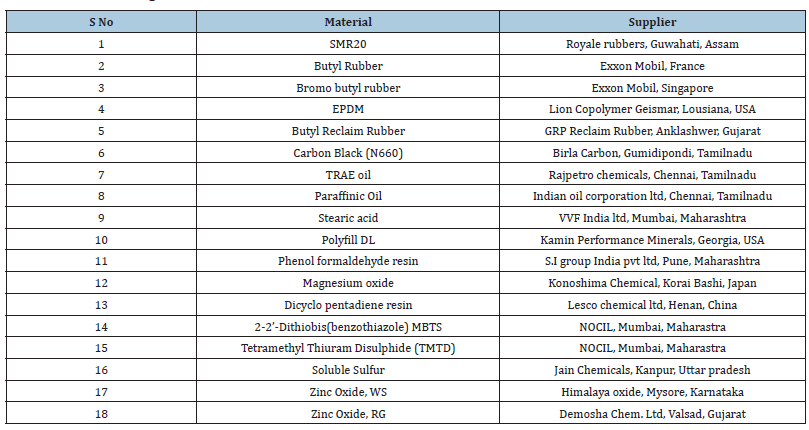
Characterization of austin black by analytical tools
Thermogravimetric analysis (TGA): The Thermogravimetric Analysis (TGA) of Austin Black was carried out by using a Thermogravimetric Analyzer (Pyris 1 TGA, Perkin Elmer, UK) under nitrogen atmosphere with a flow rate of 30ml/min, within the temperature range of 50-800 °C. All these analyses were carried out at a heating rate of 10 °C/min (ASTM D6370).
Determination of structure of austin black by DBP absorption: In determination of the structure of Austin black by DBP absorption (ASTM D 2414-19), about 20g of the sample was weighed and transferred to the absorptometer (Hitech Luxemburg) mixing chamber, and then the instrument was switched on. When the instrument stopped, the amount of DBP absorbed was recorded on a digital counter. From this result the DBP required for 100g of carbon black was calculated.
Ash content: To determine the ash content (ASTM D 1506-99), about 2g of preheated sample (125 °C/1hr) was heated at 550 °C for 16hr in a crucible. It was then taken out, covered and allowed to be cooled at room temperature. The covered crucible is again heated for 0.5hr. Above process is repeated till constant weight is obtained. The constant weight of the crucible was taken which determined the ash content.
Pour density: Pour Density is determined by measuring the mass of carbon black in a known volume. Pour Density (ASTM D 1513-05) was determined by taking carbon black in 1000ml tared container such that it forms a cone above the rim of the cylindrical container, the excess amount above the rim is levelled by a single sweep of spatula held perpendicular to and in light contact with the lip of the container. Then the mass of the carbon black is recorded in gram which is taken in the container.
pH: To determine the pH (ASTM D 1512-95), about 5g of sample was crushed in a mortar and then put in a 100-mL beaker to which 50mL of distilled water was added. The mixture was then boiled for 10min after which the beaker was covered with watch glass until cooled. The supernatant liquid was poured off, and the pH was determined from the remaining slurry by a pH meter (Orion Versa Star, Thermo Scientific, USA).
Metal content: The ash obtained from ash content test was dissolved in HCl solution and the dissolved part has been taken for the analysis of metal content. HCl dissolved ash mostly contain regular metal ions such as Ca, Mg, Zn etc. The test was carried out using iCAP 7000 series, ThermoFisher Scientific, USA under Argon atmosphere.
Heat loss: Due to hygroscopic nature of Carbon Black Heat loss (ASTM D 1509-95) was determined by heating a sample of 2gm in oven at 125 °C for 1hr and the loss in weight was noted.
Toluene discoloration: Toluene Discoloration value provides the amount of toluene soluble discolouring residue present in the black. This is used for controlling the reaction processes for carbon black production. To determine the toluene discoloration (ASTM D 1618-99), about 2g of pre-heated sample was taken in a flask and 20ml of toluene was added and shaked vigorously. The liquid was then filtered, the filtrate is taken and placed into spectrophotometer and the percent transmittance is obtained at 425nm is compared with pure toluene (Lambda 365, Perkin Elmer, UK
Wet sieve residue: 100g of carbon black was taken and pass the water from the funnel to the sieve, wash the sieve until the running water is clear. The residue was collected and dried and weighted. (ASTM D1514-04). Sieve Residue is important as it may relate to surface appearance of the product.
Swelling index: The swelling index was measured in accordance with ASTM D3616. 0.2 to 0.3g of sample was kept in toluene for 48hr at ambient temperature. After that, those samples were taken out, any excess solvent on the surface was wiped quickly using some tissue paper and weighed. Using the following equation Swelling Index (SI) was calculated

Determination of surface structure with SEM: Silver paint was put on a metal stuff, and one pellet of carbon black was placed on it. Then it was sputtered to coat with gold and a photograph was taken by scanning electron microscopy (SEM; JEOL, Japan).
Particle size distribution by master sizer laser distribution (MS 3000): Particle sizes were measured using a laser diffractometer with a Mastersizer 3000 with a Hydro dispersion unit (Malvern Instruments Ltd. UK). The refractive indices for water and carbon were given as 1.33 and 1.746 respectively. Sample was dispersed in ethanol followed by 5min ultra-sonication. Then 20ml ultrapure water containing 5% surfactant added into it followed by probe sonication (120 cycles with 40% power). Each sample was tested three times using a stirrer speed of 2800rpm and an obscuration value of around 5%.
Preparation of rubber compounds: The compound formulation is given in Table 3 & 4. All blends have the same chemical composition, except for the amounts of Process Oil, Carbon Black, S and Accelerator, which were varied to prepare the samples for better barrier and mechanical properties [8-11]. The compounds were mixed in two steps. Mixing of rubber compound was carried out using a laboratory Banbury mixer having a two-wing tangential rotor of 1.5L capacity from M/s Steward Boling. Master batch was done by setting the Temperature Control Unit (TCU) at 90 °C and rotor speed at 60rpm. After a total of 4min mixing, the master batch was dumped. The display dump temperature of master batch was found to be within 110–120 °C. The master batch was sheeted out in a laboratory two-roll mill. Further mixing of final batch was carried out after a maturation period of 8h. Temperature controller unit was kept at 90 °C and rotor speed at 30rpm to mix the final batch. Curing package, that is, accelerators and sulfur (also ZnO in Case of Inner Liner Compound) were added in a second mixing step on the same Banbury at zero second and the batch was dumped after 3min. The dump temperature of the batches was found to be within 90–100 °C [12-14]. The final batch was also sheeted out on a laboratory two-roll mill. In case of inner liner compound 17phr of N660 was replaced by more than double i.e., 35phr of Austin Black and in case of tube compound 10phr of N660 was replaced by 15phr of Austin Black
Table 3:Inner liner compound formulation.
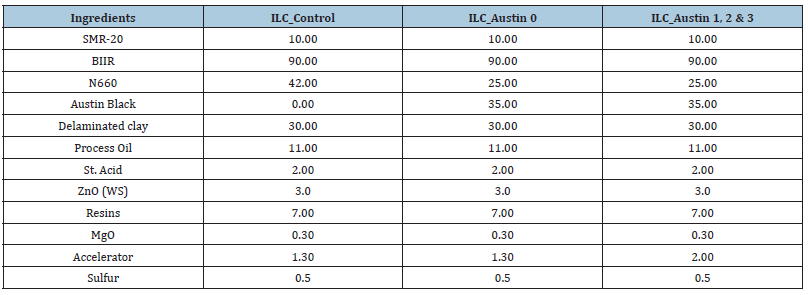
Table 4: Tube compound formulation.

Rheological Properties
Viscosity
Mooney viscosity & Mooney Scorch of the rubber compounds were tested by using Mooney viscometer (MV2000, Alpha technologies, Akron, USA, ASTM D1649)
Process safety
Mooney scorch of the rubber compound is well known as process safety, tested by using Mooney viscometer (MV2000, Alpha technologies, Akron, USA, ASTM D1649).
Physical properties
Cure behaviour: Cure time and cure torque were tested in Premier MDR2000, Alpha technologies, Akron, USA at 160 °C for Inner Liner compounds & 186 °C for Tube Compound. The Cure Index (CRI) was calculated as [100/ (tc90-ts2)].
Tensile & tear test: The compounds were vulcanized to their optimum cure time(tc90) with 1.3 times (for BIIR) and 2 times (for IIR) by using a Hind hydraulic laboratory curing press at 160 °C for Inner Liner Compound & 186 °C for Tube Compound at 150Kg/ cm2. Die C dumbbell test specimen were prepared and then tensile properties (i.e., modulus, tensile strength, elongation at break) were tested at Zwick tensile tester model Z010 (Zwick Roell group, Ulm, Germany) at a cross head speed 500mm/min according to ASTM D412. Die C angular tear test specimen un-nicked test piece with a 90° angle on one side and with tab ends were prepared and then tear properties (i.e., tear strength) were tested at Zwick tensile tester model Z010 (Zwick Roell group, Ulm, Germany) at a cross head speed 500mm/min according to ASTM D642. Dumbbell hardness test was carried out in Durometer hardness tester according to ASTM D2240-81.
Density: Density was determined according to ISO/DIS 2781 (Method A). The equipment is used for this study is Densicom, Myungji Industries, Korea.
Material mapping by SEM-EDS: Material mapping was done at RT for test specimens. The equipment used for this study is ThermoFisher, Dreieich, Germany.
Tension set: Tension set was carried at two different conditions @105 °C & 120 °C for 5hrs in oven with 50% strain according to the standard IS 13098:2012.
Gas Impermeability test by GPT: Gas Impermeability test of cured slab (2.0±0.2 m) and diameter 8cm has done by Gas Permeability Tester (GPT) at 70 °C, 5Kg/cm2 pressure and for 24 hours, 48 hours as per standard method SS ISO 2782.
Accelerated aging and aging properties: Tensile specimen was kept in multi-cell aging oven [M/S Tempo (India) Ltd.] for 3 days at a temperature of 105 °C for halo-butyl and 120 °C for butyl rubber compound. Then the specimen was taken out and kept 1 day at room temperature. The tensile properties were then measured using a Zwick tensile tester model Z010 (Zwick Roell group, Ulm, Germany). The retention and change in physical properties after aging (A) are calculated by using Equations (1) and (2), respectively Retention, % = ((Aged Value/Unaged Value) x 100) ………… (1) A (±), % = (Retention, %) – 100 …………………………………. (2)
Here (−) sign indicates a drop and (+) sign indicates a rise in property. After aging Tensile Strength (TS) and Elongation at Break (EB) tend to drop while modulus tends to rise.
Results and Discussion
Basic characterization data of Austin Black is given in Table 5.
Table 5: Characteristic properties of austin black.

Swelling index measurement
Dispersion of Austin black was further studied by measuring the swelling index of the inner liner and tube compounds. Swelling index holds direct correlation with physical and chemical cross-link densities, higher the SI lower will be the cross-link density and vice versa. It has been observed that overall crosslink density has been increased, that is just inversely proportional result of having lower swelling index. Although chemical analysis data have not suggested better dispersion possibilities of Austin black, but still it has shown higher amount of crosslinking. This may have happened due to the presence of higher number of functional groups on the surface of Austin black (Tables 6 & 7).
Table 6:Swelling index of the inner liner compounds.

Table 7:Swelling index of the tube compounds..

Particle size distribution
he particle/aggregate size of filler affects tensile strength of rubber compounds and their Mooney scorch. Degree of reinforcement of filler increases with the decrease in filler particle/aggregate size. Finer fillers require more energy for their dispersion into elastomer and therefore are more difficult to process. This greater reinforcement leads to improved modulus and tensile strength. The largest particle size black provides the greatest scorch resistance while high structure, small particle size black usually results in reduced scorch resistance. As shown below in Figure 1, Austin black shows broader aggregate size distribution with aggregate size ranging in higher size i.e., 0.12–1000mm when compared to ASTM grade N660 i.e. 0.02–8mm. Because of this wide range distribution process ability of Austin black will be much easier although aggregate size distribution is not helpful to explain the reinforcing characteristic of Austin Black.
Figure 1: Particle Size distribution (PSD) by master sizer laser distribution (MS 3000).
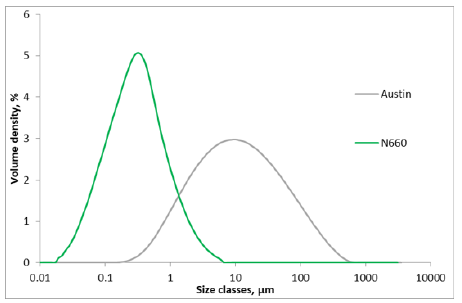
Rheological properties
Inner liner compound (ILC): As tabulated in Table 8 below, viscosity i.e. ML(1+4)@100 °C, MU for Inner Liner Compounds (ILC) was found comparable for all the compositions, viz ILC_ Control, ILC_Austin 0,1,2 and 3. Cure Rate Index (CRI) dipped to 9.8min-1 for ILC_Austin 0 formulation as compared to 12.7min- 1 for ILC_Control. To counter this effect, accelerator phr was increased to 2 for ILC_Austin 1, 2 and 3 formulations as enlisted in Table 4. Further, an increasing trend was observed for maximum torque values when going from ILC_Control to ILC_Austin 3. High maximum torque values for ILC_Austin 0, 1, 2 and 3 imply improved physical properties. However physical properties deteriorated for ILC_Austin formulations as detailed in physical properties section.
Table 8:Rheometric characteristics of inner liner compound.

Tube compound (TUC): Rheometric properties for tube compounds have been presented in Table 9. Maximum torque got reduced to 7.86 lb-in for TUC_Austin 0 when compared to 9.18 lbin for TUC_Control. To increase maximum torque for TUC_Austin 1, 2 and 3 formulations, amount of process oil was reduced to 18phr from 25phr as detailed in Table 5. In effect to decrease in amount of process oil for TUC_Austin 1, 2 and 3, viscosity followed an increasing trend from 50MU for TUC_Control to 67MU for TUC_Austin 3. Similar to ILC_Austin formulations, cure rate index for TUC_Austin 0 dropped to 49.5min-1 from 58.7min-1. Hence, to enhance CRI, accelerator phr was increased from 1.9 to 2.1 for TUC_Austin 1, 2 and 3. Thus comparable CRI was obtained for TUC_ Austin 1, 2 and 3 formulations. Higher maximum torque values for TUC_Austin 1, 2 and 3 infer to improved physical properties for these compounds. However as explained in next section, physical properties reduced for TUC_Austin formulations (Figure 2).
Table 9:Rheometric characteristics of tube compound.

Figure 2: Rheo curve nature of tube compound.
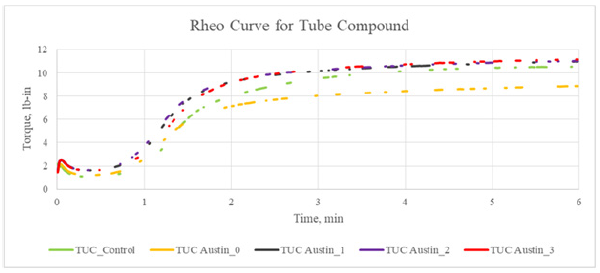
Physical properties
Unaged physical properties: The inner linear & tube of a pneumatic tire assembly must fulfil several performance requirements like retention of air pressure during the tire and inner tube service life (i.e. low air permeability), durability (from oxidation, ozonolysis, heat, and aging), tear resistance, low growth (i.e. low tension set) during service and non-stickiness of the inner tube to the tire casing during service (heat resistance & retention of physical properties) [15,16]. Some of these properties have been evaluated and discussed in the forthcoming sub-sections.
As shown in Tables 10 & 11 below, tensile strength exhibited a decreasing trend when going from control to Austin black formulations, both for inner liner as well as tube compounds. Tensile strength reduced from 8.6MPa for ILC_Control to 5.8MPa for ILC_Austin 3. Similarly, the property decreased from 9.7MPa for TUC_Control to 8.7 for TUC_Austin 0. This is in contrast to enhanced maximum torque values obtained for Austin black formulations as detailed in section 4.2. The deterioration of tensile properties for Austin black formulations can be explained by the non-reinforcing nature of this black. As the reinforcement decreases, the polymer - filler interaction becomes less and the tensile strength decreases. The non-reinforcing nature of Austin black can be demonstrated through Oil Absorption Number (OAN). A high OAN corresponds to higher structure i.e. a higher degree of branching and clustering of the aggregates [17]. As can be referred from (Table 3), OAN for Austin black is quite lower i.e. ~64ml/100g when compared to 90±5 for ASTM grade N660 black. This can be attributed to the manufacturing process of Austin black which involves mechanical grinding of bituminous coal. Mechanical grinding leads to breakage of bridges between the particles. It is believed that some of the bridges become so weak in the process of grinding that they become quite vulnerable to disruption while getting dispersed in the rubber matrix [18]. These weak bridges lead to the formation of a transient structure. This transient structure is not found to be present in the final rubber compound and is measured via DBP absorption test [Dibutylpthalate absorption test]. Due to non-existence of transient structure in the final rubber compound, discrepancies may arise between DBP absorption data and the experimentally determined compound properties. Thus, NSA [Nitrogen surface area] is considered to be an effective technique to eliminate such aberrations.
The obtained data for hardness is presented in Tables 10 & 11. For, inner liner compounds, hardness was found to be comparable among all the formulations. However, hardness increased from 54 Shore-A for TUC_Control to 58 Shore-A for TUC_Austin 3. This can be attributed to decrease in process oil amount from 25 to 18phr for TUC_Control vs TUC_Austin 1, 2 and 3. As per (Tables 10 & 11), tear strength for inner liner compounds was obtained to be comparable but for tube compounds tear strength increased from 24.8MPa for TUC_Control to 27.9MPa for TUC_Austin 3. This again can be due to reduction in process oil phr for TUC_Austin 1, 2 and 3. Improved tear strength for tube compounds imply less tearing which in turn relates to decreased magnitude of punctures and puncture size. This results in minimized repair work. Tension set @105 °C & 120 °C for ILC Austin formulations indicates higher set properties ~10-15% when compared to ILC_Control as shown in Table 10. Similarly, tension set @105 °C & 120 °C for TUC Austin formulations indicate higher set properties ~5-10% when compared to TUC_ Control as shown in Table 11. As can be referred from (Table 10), gas permeability values decreased from 3.95E-17m2/Pa.s for ILC_Control to 3.16E-17m2/Pa.s for ILC_Austin 1. On a similar trend, the values as per (Table 11), decreased from 1.03E-16m2/ Pa.s for TUC_Control to 7.04E-17m2/Pa.s for TUC_Austin 2. These decreasing trends for both inner liner as well as tube compounds indicate better gas impermeability for Austin black formulations when compared to control ones.
Table 10:Unaged physical properties of inner liner compound..

Table 11:Unaged physical properties of tube compound.

Aged physical properties: As part of investigation involving effect of oxidative (aerobic) thermal aging on stress–strain properties, ageing experiments were conducted. Results of the same have been depicted as retention percentage in Figure 3. Austin black formulations for both inner liner as well as tube compounds exhibited better retention in modulus whereas poor retention was observed for tensile strength and elongation at break. The percentage change (±) in physical properties is calculated using Equation 1. As represented in Figure 3, moduli and hardness for all the compounds increased after ageing. This could be attributed to cross-link density enhancement via enhanced functionalities on the surface of Austin Black (i.e. hardening) [19,20]. Also, as can be referred from (Figure 3), elongation at break for all the compounds dropped after ageing.
Figure 3: Aged retention properties of ILC (A) and TUC (B) compounds.
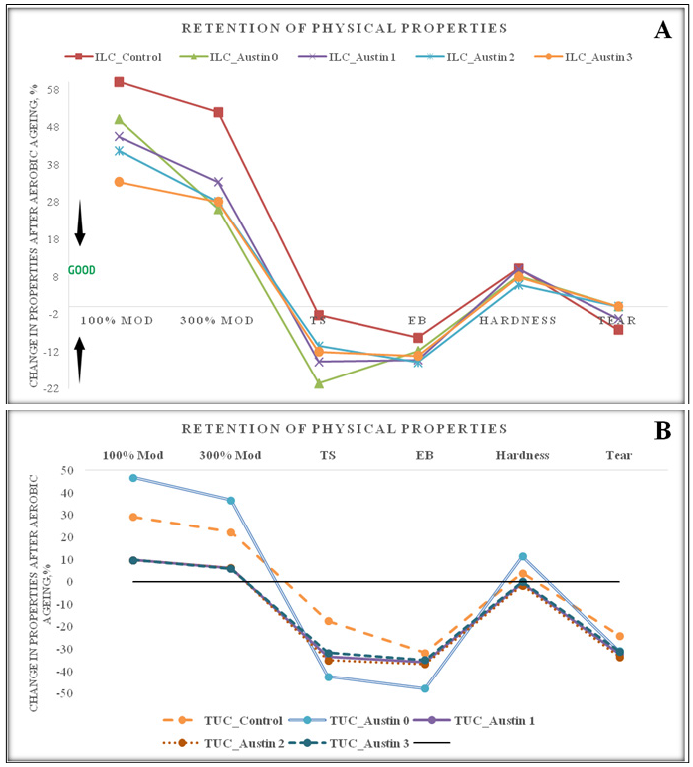
SEM analysis: Scanning Electron Micrography was conducted for raw material N660 and Austin Black so as to understand their properties from a microstructural viewpoint. As shown in Figure 4, aggregates of N660 ranged from 55 to 90nm whereas those of Austin Black were larger in size ranging from 750nm to 1.8mm and platy in structure.
Further, the aggregates of Austin Black were less homogenous and much larger than that of N660. Larger size aggregates correlate to lesser number of primary particles per agglomerate. Size and bulkiness of both aggregates and agglomerates are described by the term structure. High structure indicates that there are larger number of primary aggregates per agglomerate, whereas low structure relates to weak aggregation. Thus, it can be concluded from (Figure 4), that the structure of Austin Black was lower than that of N660, which was rather moderate. Structure plays an important role in the reinforcement properties of any carbon black [21]. Low structure carbon blacks pack more tightly than high structure ones and are thus more difficult to disperse during the mixing stage [22,23]. Hence, the microstructural analysis corroborated the nonreinforcing nature of Austin Black which could be very well seen in the physical properties (Figure 5).
Figure 4:Representative images of particle size through SEM at 5000X & 20,000X of N660 (a,b) and Austin black (c,d) sample.
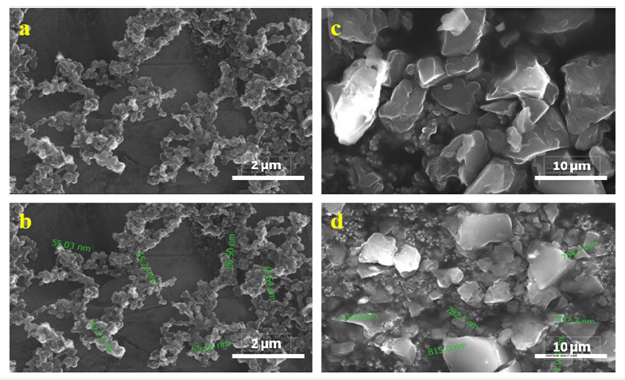
Figure 5SEM images of tensile fractured dumbbells for ILC-Control (A) and ILC-Austin 0(B), 1(C), 2(D) & 3(E) compounds at 5000X.
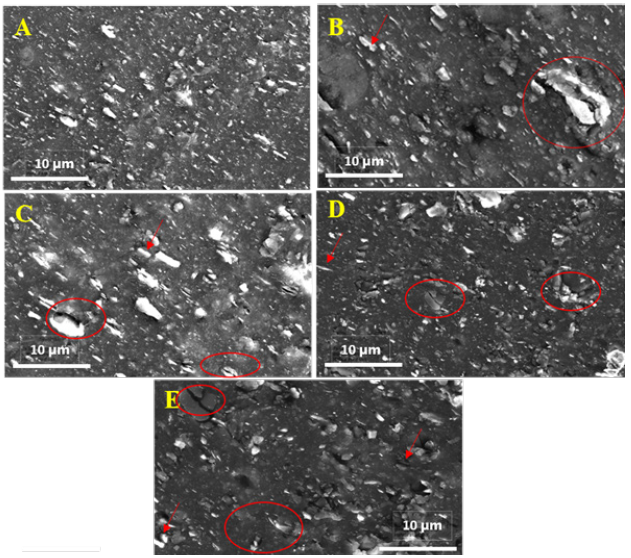
For 20000X magnification (Figure 6), image of ILC_Austin1 (F) is representative for the entire ILC Austin formulations viz. ILC_ Austin 0, 2 and 3 as all of them had similar structural micrographs. As shown in Figure 5 in ILC-Control compound, only clay particles were observed to be uniformly distributed with no big aggregates. As per (Table 4), formulations of inner liner compounds contained 30phr delaminated clay along with Austin black. Since, both clay and Austin black have very similar structural properties, thus it was difficult to distinguish between both through FESEM technique. However, an attempt was made to differentiate between the two. As shown in Figure 5, it was inferred that for ILC_Austin 0 to 3 compounds, bigger agglomerates (circled in red) could be identified as Austin Black while the smaller plate-like structures (arrowed in red) represented clay particles. As Austin black existed as big agglomerates in the compounds, thus it could be concluded that Austin black posed difficulties during its dispersion and resulted in inferior tensile properties for ILC_Austin 0, 1, 2 and 3 compounds as detailed in earlier section [24]. For 20000X magnification, image of TUC_Austin1 (f) is representative for the entire TUC Austin formulations viz. TUC_Austin 0, 2 and 3 as all of them had similar structural micrographs. As shown in Figures 7 & 8, tensile fractured surface of both ILC and TUC compounds mixed with N660 i.e. ILC_ Control and TUC_Control; appeared to be smooth, thus exhibiting the fracture mechanism characteristic for elastomers. After addition of Austin Black, the topography of the surface became rougher with several micro structural irregularities. The wrinkles, undulations, branching, and ridges could be seen in Figures 7 & 8.
Figure 6SEM images of tensile fractured dumbbells for ILC-Control (F) and ILC Austin1 (G) compounds at 20000X.
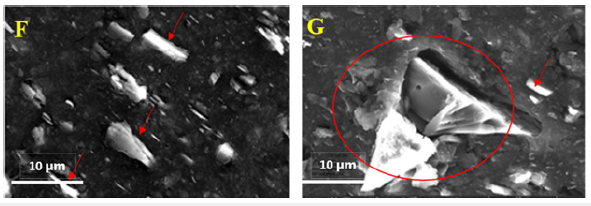
Figure 7SEM images of tensile fractured dumbbells for TUC-Control (a) and TUC_Austin 0, 1(b), 2(c) & 3(d) compounds at 5000X.
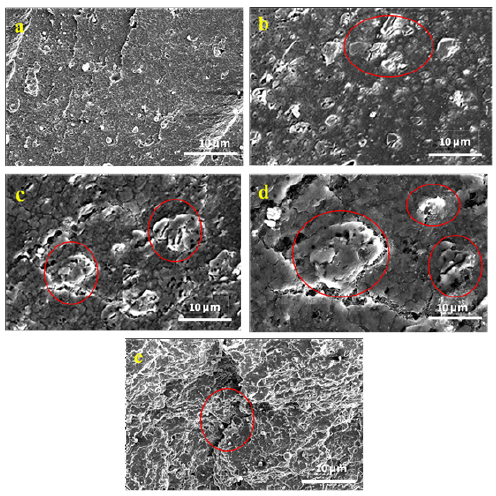
Figure 8SEM images of tensile fractured dumbbells for TUC-Control (f) and TUC Austin1 (g) compounds at 20000X.
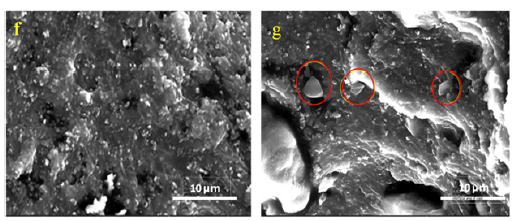
Conclusion
For each inner liner and tube compound three different formulations were mixed with 35phr of recycled Austin Black along with 25phr of N660, whereas control was mixed without any Austin Black and with 42phr of N660. Tensile strength exhibited a decreasing trend when going from control to Austin black formulations, both for inner liner as well as tube compounds. The deterioration of tensile properties for Austin black formulations can be explained by the non-reinforcing nature of this black. Tear strength for inner liner compounds was obtained to be comparable but for tube compounds tear strength increased 2 to 3 units from 24.8MPa for Control to Austin black containing mixes. Improved tear strength for tube compounds imply less tearing which in turn relates to decreased magnitude of punctures and puncture size. This results in minimized repair work. Tension set @105 °C & 120 °C for inner liner Austin formulations indicates higher set properties ~10- 15% when compared to inner liner control. Similarly, tension set @105 °C & 120 °C for tube Austin formulations indicates higher set properties ~5-10% when compared to tube control. For inner liner gas permeability values decreased 0.4 to 0.7 units as compared to control which has a value of 3.95E-17m2/Pa.s. On a similar trend gas permeability of tube reduced even up to 7.04E-17m2/Pa.s for Austin black formulations as compared to control which shows a relatively higher value of 1.03E-16m2/Pa.s. This indicates better gas impermeability for sustainable recycled black formulations when compared to control ASTM grade ones.
As part of investigation involving effect of oxidative (aerobic) thermal aging on stress–strain properties, ageing experiments were also conducted. Results of the same have been depicted as retention percentage. Austin black formulations for both inner liner as well as tube compounds exhibited better retention in modulus whereas poor retention was observed for tensile strength and elongation at break. Moduli and hardness for all the compounds increased after ageing. This could be attributed to cross-link density enhancement via increased functionalities (i.e. hardening). Also elongation at break for all the compounds dropped after ageing. This can be explained by the loss of flexibility in the compounds due to enhanced crosslink density. So, from the above observation it can be concluded that partial replacement of ASTM grade black sustainable recycled black in case of tyre and tube product line not only brings sustainability through materials aspect (by lowering the dependency of ASTM grade black with a more sustainable bituminous coal-based Austin Black) but also have a positive impact on air impermeability and other physical properties.
References
- Fillers for polymer applications. Carbon black as a polymer filler. Spahr ME, Rothon R (Eds.), Part of the Polymers and Polymeric Composites: A Reference Series book series (POPOC). pp. 261-291
- Adventures in Carbon Black by Frank Karl.
- http://www.naturalpigments.com/bone-black-pigment.html
- http://www.harwick.com/products/1201/Austin-blackreg-325
- http://rrchem.in/Austin-black-325/
- https://coalfillers.com/Austin-black-325
- Yiran F, Fowler GD, Zhao M (2020) The past, present and future of carbon black as a rubber reinforcing filler–A review. Journal of Cleaner Production 247: 119115.
- Dick John S (Edt.), (2020) Rubber technology: compounding and testing for performance. Carl Hanser Verlag GmbH Co KG, Germany.
- Waddell WH, Tsou AH (2004) Butyl rubber. Rubber Compounding, Chemistry and Applications.
- Stuck BL, Czomba PM, Freeman RA, Schill MJ, Decker DL (2005) 4-E cure systems. Rubber world 231(6): 36-42.
- Fusco JV, Hous P (1987) Butyl and halobutyl rubbers. Rubber Technology, Springer, Boston, USA, pp. 284-321.
- Van Amerongen GJ (1964) Diffusion in elastomers. Rubber Chemistry and Technology 37(5): 1065-1152.
- Bharat SB, Rodgers B, Tracey D, Tambe N, Rouckhout D (2006) Tire halobutyl rubber innerliner processing guidelines. Rubber Mini Expo 06: 170th Technical Meeting of the American Chemical Society, Rubber Division 2006.
- Solis S, Rodgers B, Tambe N, Sharma BB, Waddell WH (2005) A review of the vulcanization of isobutylene-based elastomers. ACS Rubber Division Meeting, San Antonio, USA.
- Brendan R, Webb RN, Weiqing W (2006) Advances in tire inner liner technologies. Rubber World 234(3): 36-41.
- Motar MA (2017) Inner tube of Al-Diwanyia tyre based on natural rubber blends. IBN Al-Haitham Journal for Pure and Applied Science 23(1): 272-276.
- Brendan R, Waddell W (2005) The science of rubber compounding. Science and Technology of Rubber, Academic Press, USA, pp. 401-454.
- Ismail H, Nordin R, Md Noor A (2002) The comparison properties of recycle rubber powder, carbon black, and calcium carbonate filled natural rubber compounds. Polymer-Plastics Technology and Engineering 41(5): 847-862.
- Merton SL, Huffman EWD, Wolfe AC, Nabors LG (1956) Oxygen-containing groups on the surface of carbon black. Industrial & Engineering Chemistry 48(1): 162-166.
- Norman DT (1990) Rubber grade carbon blacks. The Vanderbilt Rubber Handbook 13: 397.
- Chaala A, Roy C, Ait-Kadi A (1996) Rheological properties of bitumen modified with pyrolytic carbon black. Fuel 75(13): 1575-1583.
- Boonstra BB (1967) Mixing of carbon black and polymer: interaction and reinforcement. Journal of Applied Polymer Science 11(3): 389-406.
- Wijayarathna B, Chang WV, Salovey R (1978) Effects of processing variables on the mechanical properties of carbon black filled rubber. Rubber Chemistry and Technology 51(5): 1006-1022.
- Liu Y, Li L, Wang Q, Zhang X (2011) Fracture properties of natural rubber filled with hybrid carbon black/nanoclay. Journal of Polymer Research 18(5): 859-867.
© 2022 Saikat Dasgupta. This is an open access article distributed under the terms of the Creative Commons Attribution License , which permits unrestricted use, distribution, and build upon your work non-commercially.
 a Creative Commons Attribution 4.0 International License. Based on a work at www.crimsonpublishers.com.
Best viewed in
a Creative Commons Attribution 4.0 International License. Based on a work at www.crimsonpublishers.com.
Best viewed in 







.jpg)






























 Editorial Board Registrations
Editorial Board Registrations Submit your Article
Submit your Article Refer a Friend
Refer a Friend Advertise With Us
Advertise With Us
.jpg)






.jpg)














.bmp)
.jpg)
.png)
.jpg)










.jpg)






.png)

.png)



.png)






